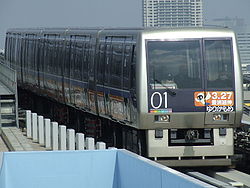Yurikamome
The Yurikamome Line ( Japanese 新 交通 ゆ り か も め , Shinkōtsū Yurikamome ; formally Japanese 東京 臨海 新 交通 臨海 線 , Tōkyō Rinkai Shinkōtsū Rinkai-sen , eng.Tokyo Waterfront New Transit Waterfront Line ) is an automated railway line in Tokyo , Japan . It is operated by the Tokyo Waterfront New Transit Corporation and connects Shimbashi with Toyosu and crosses the artificial island of Odaiba in Tokyo Bay on its way .
The line is named after the black-headed gull (Japanese yurikamome ), which is also the prefecture bird of the Tokyo prefecture .
technology
The Yurikamome is Tokyo's first fully automated transportation system. Vehicles of the Mitsubishi Heavy Industries " Crystal Mover " type are used, which are completely controlled by computers without a driver on board the train. However, it is not the first line of its kind in Japan; the Port Liner was opened in Kobe 14 years earlier in 1981 . The route length is about 14.7 km.
The Yurikamome is sometimes mistakenly referred to as a monorail . The trains, however, run on rubber tires on a concrete track guided through the side walls.
history
Before it opened in 1995, there were concerns in many places that the Yurikamome could develop into a multi-billion dollar investment ruin. Like the man-made island of Odaiba that it serves, the Yurikamome was also planned and built before the collapse of the Japanese bubble economy . A few months after it opened, the daily number of passengers was around 27,000, only slightly less than the 29,000 forecast in advance, but still much less than the 80,000 daily passengers needed to be profitable in the long term.
In 1996, however, the Tokyo city government changed its strategy for Odaiba and now allowed entertainment facilities on the island in addition to the previous focus on residential and business areas. This also includes the establishment of a local recreation area directly on the shore, as the rest of the Tokyo shoreline is dominated by ports. As a result of this realignment, the number of passengers doubled within one year to 60,000 passengers a day and was able to increase further in the following years.
However, the island was not only popular due to the new orientation of Odaiba, but also the Yurikamome itself became an attraction in itself, as it offers a good view of the banks and Odaiba over large parts of the route. A special feature of the route is the 270 ° loop on the west side of the Rainbow Bridge in order to reach the necessary height to cross the bridge.
- November 1, 1995 : The Shimbashi-Ariake section is opened, and the Shimbashi temporary station begins operations
- March 22, 2001 : The regular Shimbashi station opens, the temporary station closes
- November 2, 2002 : Shiodome train station opens
- March 27, 2006 : The Ariake-Toyosu section opens; all stations adopt numbers and letters for identification similar to the Tokyo Metro
The fare is currently (as of October 2017) 190 to 380 yen .
Train stations
The trains are let on and taken off the line at Ariake station. Trains that are not in service are in a depot at Tokyo Big Sight .
Since 2006, the announcement of the next stop has been made by seiyū ( voice actor ).



